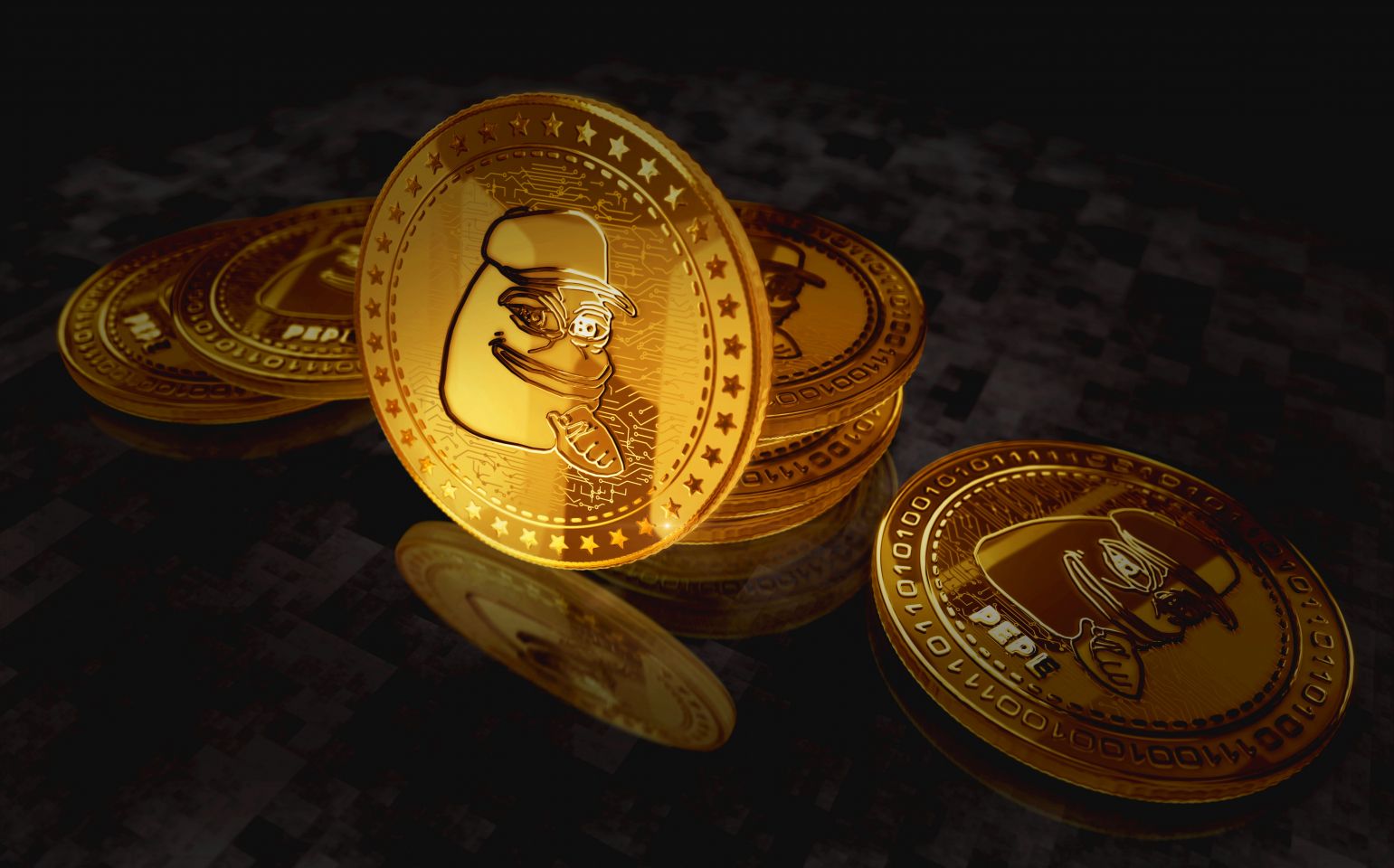What is PEPE? A trader’s guide

Learn about PEPE, including its price history, how PEPE works, and how to trade PEPE/USD with CFDs.
Go to market page
What is PEPE?
Pepe (PEPE) is a decentralised cryptocurrency that operates on the Ethereum (ETH) blockchain. Its origins are unknown, but is believed to have been created by anonymous developers. PEPE launched in April 2023.
As an ERC-20 token, PEPE runs on Ethereum’s blockchain, leveraging its security and functionality. Its initial total supply was capped at 420.69 trillion tokens, a nod to its humourous branding inspired by the popular internet meme, ‘Pepe the Frog’. This playful association has led to PEPE being referred to as a ‘meme-coin’, alongside tokens like Dogecoin (DOGE) and Shiba Inu (SHIB). But the development team has periodically burned tokens to reduce the supply; for instance, on 24 October 2023, 6.9 trillion tokens were burned.
Conceived as a lighthearted project, PEPE has garnered significant attention within the cryptocurrency community, quickly becoming a speculative trading asset. As of January 2025, PEPE ranks within the top 25 cryptocurrencies by market capitalisation on CoinMarketCap.
Like other memecoins, PEPE’s price is heavily influenced by its community, market sentiment, and online buzz rather than traditional utility or fundamentals.
PEPE vs Dogecoin vs Shiba Inu: What are the differences?
PEPE, Dogecoin, and Shiba Inu are all meme-coins. But they also have differences, which influence their role in the cryptocurrency market. Here’s how they compare:
|
PEPE |
Dogecoin |
Shiba Inu |
|
|
Origin |
Created by anonymous developers & launched in April 2023. |
Created by Billy Markus and Jackson Palmer; launched in December 2013. |
Created by an anonymous developer known as ‘Ryoshi’; launched in August 2020. |
|
Cryptocurrency |
PEPE |
||
|
Blockchain |
Ethereum, ERC-20 token standard. |
Native cryptocurrency on its own blockchain. |
Ethereum, ERC-20 token standard. |
|
Consensus mechanism |
Ethereum blockchain’s proof-of-stake (PoS). |
Proof-of-work (PoW). |
Ethereum blockchain’s proof-of-stake (PoS). |
|
Maximum token supply |
Initially 420.69 trillion tokens, periodically reduced through burns. |
Unlimited supply. |
1 quadrillion tokens. |
|
Use case |
Purely speculative, with a focus on humour and community. |
Peer-to-peer transactions and tipping. |
Decentralised finance (DeFi), non-fungible tokens (NFTs), and payments. |
|
Mascot |
Pepe the frog. |
Kabosu, a Shiba Inu dog featured in the ‘Doge’ meme. |
Shiba inu dog breed. |
|
Community |
Highly active, driven by humour, memes, and speculative trading. |
Strong and vibrant, known for tipping and social media activity. |
Known as the ‘ShibArmy’, active in DeFi, NFTs, and metaverse projects. |
|
Development focus |
Limited utility beyond its meme status. |
Payment simplicity and stability. |
An expanding ecosystem with platforms like ShibaSwap and Shibarium. |
|
Market capitalisation |
Ranked within the top 25 cryptocurrencies* |
Consistently within the top 10 cryptocurrencies* |
Consistently within the top 10–15 cryptocurrencies* |
|
Transaction speed (approximate) |
Dependent on Ethereum, which processes 12–14 transactions per second (TPS). |
Up to 33 TPS. |
Dependent on Ethereum, which processes 12–14 TPS. |
|
Inflation model |
Fixed supply, reduced over time through token burns. |
Inflationary with approximately five billion DOGE minted annually. |
Deflationary mechanisms, such as SHIB burns, reduce supply over time. |
*Based on January 2025 data from CoinMarketCap.
Check out our comprehensive trader’s guide to Shiba Inu and our guide to Dogecoin.
How does PEPE work?
PEPE is intended as a playful, meme-based token designed to foster community engagement and speculative trading. It operates as a decentralised cryptocurrency built on the Ethereum blockchain, adhering to the ERC-20 token standard. PEPE transactions rely on Ethereum’s proof-of-stake (PoS) consensus mechanism, which validates and secures transactions efficiently while maintaining decentralisation.
As a result, PEPE benefits from Ethereum’s security, transparency, and compatibility with decentralised applications (dApps) and services within the Ethereum ecosystem. However, transaction speeds and fees for PEPE are influenced entirely by the Ethereum blockchain's performance. High network congestion on Ethereum can lead to slower transaction speeds and higher fees.
PEPE released with an initial maximum supply of 420.69 trillion tokens. Over time, periodic token burns have reduced the supply, enhancing scarcity. This fixed supply, combined with ongoing reductions, contributes to its deflationary potential.
What is PEPE’s price history?
PEPE’s price history began in April 2023 when the asset launched at a fraction of a cent, reflecting its memecoin status and playful branding. Within weeks, the token gained significant traction on social media, with its humourous nod to internet meme culture capturing the attention of traders and speculators alike.
By early May 2023, PEPE’s price increased significantly from its launch price, gaining over 2,000% in value. This was influenced by a combination of hype, FOMO (fear of missing out), and significant trading volume on decentralised exchanges.
However, by mid-2023, PEPE’s price decreased partly due to early adopters selling their tokens, contributing to periods of steep price drops. Despite this, the token retained a loyal following, helping it stabilise at levels far above its initial launch price.
A regulatory crackdown
Broader market conditions, including regulatory crackdowns on cryptocurrencies in key markets and rising interest rates, put downward pressure on cryptocurrency market prices in 2024. This included PEPE, with its price fluctuating widely in response to changing market sentiment.
The US presidential election in November 2024 caused significant volatility in financial markets, including cryptocurrencies like PEPE. The election’s impact on economic policies and trading sentiment influenced broader upwards trends across the cryptocurrency market.
It's important to note that while political events can influence market dynamics, the cryptocurrency market is also subject to a variety of other factors, including technological developments, regulatory changes, and broader economic trends.
PEPE's live price may be influenced by a combination of factors, including market sentiment and broader cryptocurrency market trends.
Social media buzz and viral trends
Viral campaigns, memes, and trending hashtags may generate interest, driving sharp price increases. The humorous and lighthearted branding of PEPE encourages widespread sharing, particularly on platforms like X (formerly Twitter), Reddit, and TikTok. However, this reliance on social media makes PEPE highly sensitive to lower interest or a shift in sentiment, which could potentially influence price decreases.
Broader cryptocurrency market trends
PEPE’s price frequently mirrors the performance of major cryptocurrencies like Bitcoin (BTC) and Ethereum (ETH). A bullish market may drive PEPE’s price upward as traders seek high-risk, high-reward opportunities, while bearish trends can put downward pressure on its valuation. Key market-wide events, including regulatory announcements, central bank interest rate changes, and macroeconomic shifts, can have ripple effects on meme-coins like PEPE.
Ethereum network performance
Since PEPE operates on the Ethereum blockchain, its transaction fees (gas fees) and speeds are directly affected by Ethereum’s network conditions. High gas fees during periods of network congestion may deter trading activity, potentially putting downward pressure on PEPE’s price. Conversely, Ethereum upgrades, such as the introduction of sharding or layer-2 scaling solutions, could lower costs and enhance transaction speeds, possibly making PEPE more appealing to traders.
Speculation and market sentiment
Meme-coins like PEPE thrive on speculative trading. Rumours, influencer mentions, or unexpected announcements can result in sudden price surges or drops. Additionally, the absence of news or waning speculative interest may lead to price stagnation. Traders must remain vigilant to shifts in sentiment and speculative trends, as they can dramatically impact short-term price movements.
Media coverage and celebrity influence
Positive media attention or endorsements from influential figures can quickly drive up PEPE’s price. Conversely, negative press, such as scrutiny over meme-coins or concerns about security, may suppress demand and lead to declines. The meme-driven nature of PEPE makes it particularly susceptible to light-hearted celebrity mentions or viral endorsements, which can have significant effects on PEPE’s price movements.
What are the PEPE trading hours?
PEPE operates on a decentralised blockchain network that is active 24 hours a day, seven days a week. This means you can trade PEPE at any time, including weekends and holidays.
-
Cryptocurrency exchanges – many exchanges facilitate 24/7 trading, allowing for continuous market participation.
-
Online trading platforms – some reliable and trusted brokerages provide PEPE trading via CFDs.
If you choose to trade CFDs, you can follow the PEPE performance live in US dollars with our comprehensive PEPE/USD price chart.
Monitoring the cryptocurrency’s activity can help you to keep an eye out for any key fundamental or technical events that may affect short-term movements in its value.
How to trade PEPE
PEPE is a cryptocurrency, meaning that it can be traded directly on a cryptocurrency exchange or through peer-to-peer transactions. Traders may also choose to trade PEPE via a derivative, a financial product that takes (or ‘derives’) its value from the price of the underlying asset.
You could use a contract for difference, or CFD, to trade on the price of PEPE pairs. A CFD is a contract, typically between a broker and a trader, where one party agrees to pay the other the difference in the value of a security, between the opening and closing of the trade.
You can use CFDs to trade on whether you think an PEPE pair will rise (called ‘going long’) or fall (‘going short’). CFDs give you access to leverage, allowing larger positions with a relatively small outlay. This amplifies your potential profits, but also your potential losses, making CFD trading risky.
You can learn more about trading cryptocurrencies with Capital.com in our comprehensive guide to cryptocurrency trading.
Aside from CFDs, you can also trade PEPE pairs through instruments like futures, options, ETFs, and mutual funds. Each offers an alternative to the leveraged trading of CFDs, suiting different risk profiles and strategies.
FAQ
What is PEPE used for?
Pepe (PEPE) is primarily used as a speculative trading asset and has gained popularity as a memecoin, inspired by the internet phenomenon Pepe the Frog. PEPE’s price is influenced by factors such as its community engagement, market sentiment, and viral appeal. While it lacks traditional utility, its humour-driven branding has made it a favoured choice for meme-coin enthusiasts.
Is PEPE a good trade?
Whether PEPE is a good trade depends on your trading goals, market knowledge, and risk tolerance. As a memecoin, PEPE is characterised by high price volatility, often driven by social media trends and community sentiment. This makes it appealing to traders seeking high-risk, high-reward opportunities. However, the same volatility can result in rapid and significant losses. Always conduct thorough research, consider using risk management strategies, and never trade more than you are willing to lose.
How much PEPE is in circulation?
PEPE was launched with an initial maximum supply of 420.69 trillion tokens, all of which were pre-mined in April 2023. This means no additional PEPE tokens will ever be created, unlike cryptocurrencies like Bitcoin, where new coins are mined periodically until a maximum supply is reached. Periodic token burns have reduced the total supply, enhancing its scarcity-driven appeal. The circulating supply can vary depending on tokens held in dormant wallets, locked in smart contracts, or not yet introduced to active markets.
Where can I trade PEPE?
You can trade PEPE on various cryptocurrency exchanges, including both centralised platforms like Binance and decentralised exchanges (DEXs) such as Uniswap. Additionally, financial derivatives such as Contracts for Difference (CFDs) on platforms like Capital.com allow you to speculate on PEPE’s price movements without owning the tokens themselves. CFDs offer flexibility but carry significant risks, particularly due to leverage. Always understand the risks involved before trading derivatives.
Is PEPE a memecoin?
Yes, PEPE is widely considered a memecoin. Its branding and community-driven appeal are rooted in internet meme culture, particularly the iconic Pepe the Frog. Although memecoins like PEPE often start as humorous projects, they have become significant speculative assets within the cryptocurrency market, driven by viral trends and enthusiastic communities.
Visit our other complete guides

How to trade Solana
